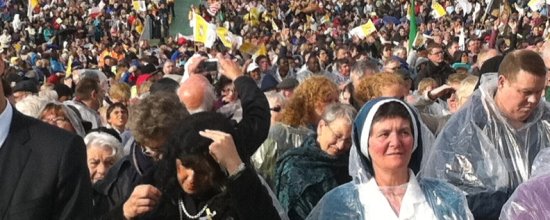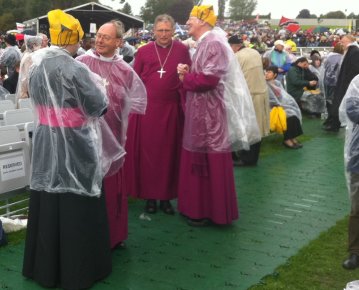
Way back in the twentieth century, when I decided to pursue doctoral work in theology, I never imagined that I would one day teach in an Oxford college. Neither did I imagine that John Henry Newman, of all people, would come to loom large in my day-to-day life. It goes without saying that I never imagined that I would find myself boarding a bus to Birmingham in the middle of the night to attend his beatification Mass. But there I was, on the road to Birmingham, along with other representatives from Oriel College, where Newman was a fellow for twenty years.
According to our invitations, the members of the Oriel delegation were “invited pilgrims.” We had been asked to attend because Oriel was the place where Newman did some of his most important intellectual work, the epicenter of the Oxford movement in the nineteenth century—and, of course, the place where Newman decided to leave the Anglican Church for good. The pace of change is slow in Oxford, so Newman’s presence still permeates Oriel. (For example, our chaplain lives in Newman’s rooms. What in other places would be a shrine is, in Oxford, just another bedroom suite.) On the other hand, the close association between Newman and Oriel is somewhat ironic, since his conversion to Catholicism brought his official association with Oriel to an end. His very last act as an Anglican was to resign his Oriel fellowship, just before his conversion in 1845. At the time, he could not hold it as a Roman Catholic.
Like all good pilgrimages, ours began in darkness and with self-mortification. The beatification ceremony was not scheduled to begin until 10 a.m., but we were asked to board our bus for the short drive to Birmingham at 4 a.m., so as to arrive, go through security, and be seated by 7. The painfully early hour caused a number of otherwise keen would-be pilgrims to reconsider the merits of this particular pilgrimage. As we collected sandwiches for lunch, they remained at home, asleep in their beds.
We arrived at the venue—Cofton Park, Birmingham—and moved without incident through various security checkpoints, including one in the showroom of a car dealership. Everyone in attendance was given a yellow bag labeled a “Pilgrim Pack,” which contained, among other curios, a guide to the liturgy, a music CD, and a rain poncho. The rain jackets proved to be important because it was in fact raining, and we had to sit outside for the next seven hours. On a brighter note, there were vendors offering coffee and doughnuts, both of which I partook of gratefully, like manna from heaven.
 As the crowd grew, the spectacle grew with it. Many people waved their national flags, or brandished handmade signs supporting the pope (“Leave our Pope alone! We love our Papa!”). There were representatives of various Catholic orders, both priestly and lay, wearing various kinds of traditional attire, including the Knights of Malta and the Guardians of the Holy Sepulchre. For their part, two Anglican bishops fashioned their yellow Pilgrim Packs into biretta-like hats to protect them from the rain. Another Anglican bishop had a crucifix with the Jesus from South Park on it. We all monitored a jumbotron, tracking the progress of the pope as he made his way by helicopter and Popemobile from London to Cofton Park. A band played Christian folk-rock—the less said about that, the better.
As the crowd grew, the spectacle grew with it. Many people waved their national flags, or brandished handmade signs supporting the pope (“Leave our Pope alone! We love our Papa!”). There were representatives of various Catholic orders, both priestly and lay, wearing various kinds of traditional attire, including the Knights of Malta and the Guardians of the Holy Sepulchre. For their part, two Anglican bishops fashioned their yellow Pilgrim Packs into biretta-like hats to protect them from the rain. Another Anglican bishop had a crucifix with the Jesus from South Park on it. We all monitored a jumbotron, tracking the progress of the pope as he made his way by helicopter and Popemobile from London to Cofton Park. A band played Christian folk-rock—the less said about that, the better.
In appropriate contrast, the beatification Mass was a solemn affair. The ceremony began with a brief account of Newman’s life. Pope Benedict then pronounced a declaration of beatification: “Acceding to the request of our brother Bernard Longley, Archbishop of Birmingham, with the Congregation for the Causes of Saints, by our apostolic authority we declare that the venerable Servant of God John Henry, Cardinal, Newman, priest of the Congregation of the Oratory, shall henceforth be invoked as Blessed and that his feast shall be celebrated every year on the ninth of October, in the places and according to the norms established by church law.” And so it was done. A portrait of Newman was unveiled, and his relics—including a lock of hair held by Trinity College, Oxford—were brought to the altar. After the beatification, the ceremony continued on largely as a regular Sunday Mass, one that happened to be celebrated by the pope. There was a little more Latin than usual, and a bigger choir, and many more concelebrants. (I am happy to report that there were several female altar servers.) The pope’s homily focused on Newman’s role as teacher and education reformer.
Pope Benedict looked frailer than I expected. As he spoke in clear but heavily accented English, I was struck by the fact that I had never heard the sound of his voice before. Even more than seeing him up close, hearing Pope Benedict talk made him seem more human to me. Not that I ever thought him other than human, but whatever else he is, the successor of Peter is now an international celebrity. Hearing Benedict talk made him seem less like a star and more like an ordinary man, a priest.
I happened to be sitting next to the parents of two teenagers who were chosen to go up to the altar as part of the service. What moved me most that day was their reaction to the sight of their children standing before the pope. It seemed to be the happiest moment of their lives. They were radiant with joy, and their happiness was infectious.
In the end, I wondered what Newman would have thought of the day’s events. I suspect he would not have approved. He wouldn’t have considered himself a candidate for sainthood, but then what deserving person would? Newman remains a cipher. No fan of papal infallibility, he called the First Vatican Council a “climax of tyranny,” and actually hoped that Pius IX would die before that dogma was promulgated. And yet, once promulgated, Newman defended it with all his considerable powers. We are meant to imitate the saints and the blessed. But which Newman should be our model— restless intellectual or loyal follower? That is an important question, and there is a place and time for trying to sort it out. But Cofton Park, Birmingham, on September 19 was not that place or time, at least not for me.
Related: Tacking toward the Truth, by Joseph A. Komonchak
'Credo in Newmanum,' by Frank Oveis; The Upstairs Room, by Mary Frances Coady

